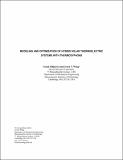Modeling and optimization of hybrid solar thermoelectric systems with thermosyphons
Author(s)
Miljkovic, Nenad; Wang, Evelyn N.
DownloadMain article, figures, and supplementary information (3.595Mb)
PUBLISHER_CC
Publisher with Creative Commons License
Creative Commons Attribution
Terms of use
Metadata
Show full item recordAbstract
We present the modeling and optimization of a new hybrid solar thermoelectric (HSTE) system which uses a thermosyphon to passively transfer heat to a bottoming cycle for various applications. A parabolic trough mirror concentrates solar energy onto a selective surface coated thermoelectric to produce electrical power. Meanwhile, a thermosyphon adjacent to the back side of the thermoelectric maintains the temperature of the cold junction and carries the remaining thermal energy to a bottoming cycle. Bismuth telluride, lead telluride, and silicon germanium thermoelectrics were studied with copper–water, stainless steel–mercury, and nickel–liquid potassium thermosyphon-working fluid combinations. An energy-based model of the HSTE system with a thermal resistance network was developed to determine overall performance. In addition, the HSTE system efficiency was investigated for temperatures of 300–1200 K, solar concentrations of 1–100 suns, and different thermosyphon and thermoelectric materials with a geometry resembling an evacuated tube solar collector. Optimizations of the HSTE show ideal system efficiencies as high as 52.6% can be achieved at solar concentrations of 100 suns and bottoming cycle temperatures of 776 K. For solar concentrations less than 4 suns, systems with thermosyphon wall thermal conductivities as low as 1.2 W/mK have comparable efficiencies to that of high conductivity material thermosyphons, i.e. copper, which suggests that lower cost materials including glass can be used. This work provides guidelines for the design, as well as the optimization and selection of thermoelectric and thermosyphon components for future high performance HSTE systems.
Date issued
2011-11Department
Massachusetts Institute of Technology. Department of Mechanical Engineering; Massachusetts Institute of Technology. Device Research LaboratoryJournal
Solar Energy
Publisher
Elsevier
Citation
Miljkovic, Nenad, and Evelyn N. Wang. “Modeling and Optimization of Hybrid Solar Thermoelectric Systems with Thermosyphons.” Solar Energy 85, no. 11 (November 2011): 2843–2855.
Version: Author's final manuscript
ISSN
0038092X